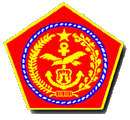|
Gegana adalah bagian dari Kepolisian Indonesia (Polri). Pasukan ini mulai ada sejak tahun 1976, meski
ketika itu baru berupa detasemen. Baru pada tahun 1995, dengan adanya pengembangan validasi Brimob bahwa kesatuan ini harus
memiliki resimen, Detasemen Gegana lalu ditingkatkan menjadi satu resimen tersendiri, yakni Resimen II Brimob. Tugas utama
Gegana ada tiga: mengatasi teror, SAR dan Jihandak (penjinakan bahan peledak).
Secara umum, hampir semua anggota Gegana mampu melaksanakan ketiga tugas utama tersebut. Namun, kemampuan
khusus yang lebih tinggi hanya dimiliki oleh orang-orang tertentu. Gegana tidak memiliki Batalyon atau pun Kompi. Kesatuan
yang lebih kecil dari resimen adalah detasemen. Setelah itu subden dan yang paling kecil adalah unit. Satu unit biasanya terdiri
dari 10 orang. Satu subden 40 orang, dan satu detasemen beranggotakan 280-an orang.
Satu operasi biasanya dilakukan oleh satu unit. Karena itu, dari sepuluh personel dalam satu unit tersebut,
harus ada enam orang yang memiliki kemampuan khusus. Masing-masing: dua orang memiliki kemampuan khusus yang lebih tinggi
di bidang jihandak, dua orang di bidang SAR dan dua lagi ahli teror. Kedua orang itu disebut operator satu dan operator dua.
Yang lainnya mendukung.
Misalnya untuk teror: operatornya harus memiliki keahlian menembak jitu, harus memiliki kemampuan negosiasi,
ahli dalam penggebrekan dan penangkapan. Namun semuanya tidak untuk mematikan. Sebab setiap operasi Gegana pertama-tama adalah
berusaha untuk menangkap tersangka dan menyeretnya ke pengadilan. Kecuali dalam keadaan terpaksa, yang mengancam jiwa orang
yang diteror, barulah terpaksa ada penembakan. Sementara untuk SAR, dituntut memiliki kemampuan dasar seperti menyelam, repling,
jumping, menembak, juga P3K.
Demikian pula, operator jihandak harus memiliki keahlian khusus di bidangnya. Setiap anggota Gegana
secara umum memang sudah diperkenalkan terhadap bom. Ada prosedur-prosedur tertentu yang berbeda untuk menangani setiap jenis
bom, termasuk waktu yang dibutuhkan. Kepada anggota Gegana jenis-jenis bom tersebut dan cara-cara menjinakkannya, termasuk
risiko-risikonya, sudah dijelaskan.
Gegana baru punya tiga kendaraan taktis EOD (explosive ordinance disposal) yang sudah lengkap dengan
alat peralatan. Padahal seharusnya, setiap unit memiliki satu kendaraan taktis. Selain di Gegana, kendaraan EOD masing-masing
satu unit ada di Polda Jawa Barat, Jawa Tengah, dan Jawa Timur. Jadi se-Indonesia baru ada enam unit.
Komando tertinggi setiap operasi Gegana langsung berada di bawah Kapolri yang dilaksanakan oleh Asop
Kapolri.
(Sumber: http://www.tempo.co.id/harian/profil/gegana.html)
|
 |
Gegana is the Indonesian Police special
unit. This unit was formed in 1976 as a detachment. Later in 1995, with the expansion of Brimob, the Gegana Detachment was
expanded to become 2nd Regiment Brimob. Its duties are anti-terror, search and rescue (SAR), and explosive disposal
operations. In general, each Gegana personnel is capable to perform those duties. However, there are selected few who are
very skillful in these special duties.
Gegana does not have Batalyon or Company.
Regiment is broken down into several detachment. Within detachment there are several sub-detachment (sub-den), and within
sub-den there are several units. Each unit usually consists of 10 personnels. One sub-den consists of 40 personnels, and one
detachment consists of about 280 personnels.
One operation is usually assigned to
one unit. Therefore, from the 10 personnels in that unit, six have to have the special skills: two for disposing explosives,
two for SAR operation, and two for anti-terror operation. In each operation, the two experts become Operator One and Operator
Two while the rest of the unit members become the Support Team.
For example, in the anti-terror operation,
the operator must have sharp-shooting skills, ability to negotiate, and an expert in storm-and-arrest operations. These skills
and operations are not lethal because the first goal of every Gegana operation is to arrest suspects and bring them to the
court. Unless there is a situation that Gegana has to do otherwise, there will be no shooting.
In SAR operation, the personnels are
required to have the basic capabilities of diving, rappeling, shooting, and first aid. In anti-bomb operation, the Operators
have to be the expert in their fields. Each Gegana personnel has been introduced to various types of bombs in general, including
the risks of handling them. There are specific procedures for handling each bomb, including the required timing.
Currently, Gegana has three Explosive
Ordinance Disposal (EOD) tactical vehicles. This number is far from sufficient because ideally each Gegana unit is supposed
to have one. Other then three EOD vehicles at Gegana offices, there is one EOD vehicle in West Java Police Department (PD),
Central Java PD, and East Java PD. So, overall there is only six EOD unit available in Indonesia.
The Indonesian Police Chief has the
highest command in each Gegana operation, executed by his Operation Assitant.
(Source: http://www.tempo.co.id/harian/profil/gegana.html)
|

